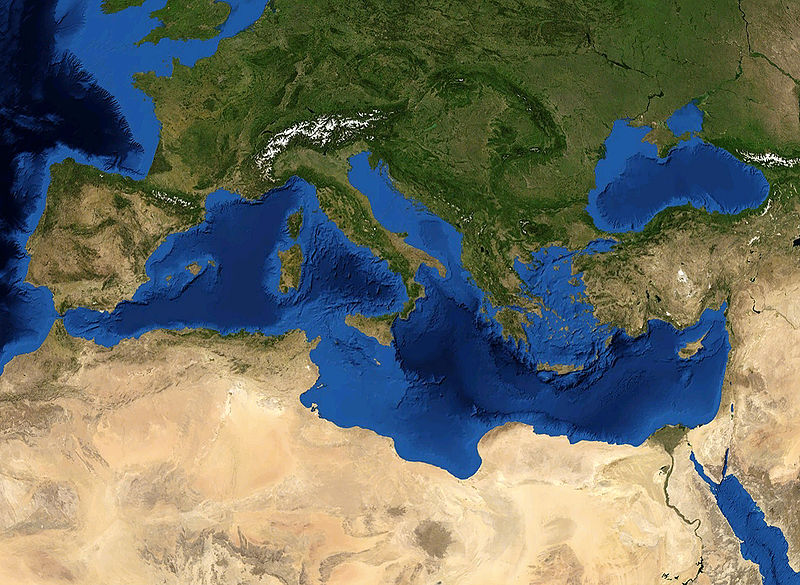The latest Geosciences Column is brought to you by Annabel Slater, who describes a time of dramatic change in the Mediterranean. Slater shares the results of a recently published Climate of the Past study and sheds light on how – in the context of global climate – a little salt can go a long way…
Many of us worry about the effects of too much salt on our health, not its effects on global climate. Often the amount we get goes up and down as we sprinkle miserly, health-conscious pinches into cooking, or give in and gladly seize the salt shaker when there’s a cone of chips in hand. Over 5 million years ago, the Mediterranean Sea also experienced salty extremes, swinging from periods of hypersalinity to salinities so low, it approached freshwater. Now, for the first time, scientists from the UK and Germany have shown that this variable Mediterranean salt diet could have had weighty consequences for global climate.
Around 5.96 – 5.33 million years ago during the latest Miocene period, the Messinian, tectonic changes closed off the Mediterranean Sea from the Atlantic Ocean. The salinity of the Mediterranean Sea fluctuated dramatically as water evaporated, increasing salt concentrations up to ten times what they are today. At other times, regions of near-fresh water accumulated as water flowed in from surrounding rivers and lakes. This event is known as the Messinian Salinity Crisis, and its story is written out in sequences of evaporites and rich fossil records of brackish marine species in the region.

An artist’s impression of the Messinian Salinity Crisis. (Credit: Wikimedia Commons user Paubahi)
It had long been thought that, during the event, the Mediterranean Sea remained isolated from the Atlantic and even dried up completely. But recent research suggests that periodically, the connection was remade and outflows of either hypersaline or brackish Mediterranean water flowed into the Atlantic Ocean, like it does today through the Strait of Gibraltar.
The Atlantic Ocean hosts a major ocean current, the Atlantic Meridionial Overturning Circulation (AMOC), which circulates warm surface water from the mid-Atlantic to the higher Arctic latitudes. This looping current is powered by changes in water density, based on temperature and salt content. The more salt there is in water, the denser it is, and the deeper it sinks. The movement of the AMOC influences worldwide ocean circulation and climate. So what would have been the consequences of receiving this variable Mediterranean salt diet?
Led by Ruza Ivanovic, a team of scientists from the University of Leeds and the University of Bristol, UK, and GEOMAR Helmoltz Centre for Ocean Research, Germany, ran several simulations to investigate the effects of fluctuating salt input. They used a climate prediction model known as HadCM3 from the UK Met Office to generate several scenarios of Mediterranean water outflow.
Their simulations showed that any Mediterranean outflows during the Messinian Salinity Crisis would cause significant cooling. Outflows of the saltiest, densest water would cause a shift in the AMOC pattern, and cooling of a few degrees as far north as the Labrador and the Greenland-Iceland-Norwegian seas. But outflows of the freshest water would completely shut down the AMOC and generate a bipolar climate effect. Strong cooling reaching –8 degrees Celsius would occur in the northern seas, with weak warming occurring in the south. This simulation also showed a lasting southern shift in precipitation patterns.

The Mediterranean Sea today. (Credit: NASA/Eric Gaba)
These are the first major findings to unveil a connection between the Messinian Salinity Crisis and worldwide changes in climate. The simulations also show that flows or lack of flow from the Mediterranean Sea had more impact on the AMOC then, in comparison to conditions today. Palaeoclimate researchers investigating this relationship will now know where to look and also what to look for to find more evidence. As the North Atlantic sea surface temperature showed the most variability throughout all the simulations, the team think this region could be key to confirming their modelled results.
And as more evidence is uncovered about the connections between the Mediterranean and the Atlantic, the team will be able to refine their simulations to find out more about the duration and reach of the Messinian Salinity Crisis’ effects.
With much about the cause and nature of the Messinian Salinity Crisis still unknown, this research is a new step towards unpicking the mystery. One thing seems clear – either a little or a lot of salt can go a long way.
By Annabel Slater, Freelance Science Writer
Reference:
Ivanovic, R. F., Valdes, P. J., Flecker, R., and Gutjahr, M.: Modelling global-scale climate impacts of the late Miocene Messinian Salinity Crisis, Clim. Past, 10, 607-622, 2014.




Silvestro Lazzari
Iniziativa molto interessante. Aderiamo al gruppo.